
Concurrent Panel Session Six
The Villains of Our Stories: Marvel and the Increasing Need to Diversify Their Films
Start Date
7-4-2018 3:00 PM
End Date
7-4-2018 3:50 PM
Abstract
The Marvel Cinematic Universe is often commended for transcending boundaries through their shared universes, transformation of the superhero film genre, and the sheer volume of box office successes. Yet this acclaim does little to hide the lack of complexity in their villains, most of whom are superficial white men positioned against heroic white men, predictable in motivation, and creating a stagnation of little impact and cultural commentary. Even early attempts to subvert expectations, with female sidekicks and Asian coded villains revealed to be white men, furthered the patterns of centralized white male focus. A way to reverse this trend has become obvious, however, with the foundation for developing nuanced villains and stories increasingly evident. When Marvel films increase diversity behind the camera and in the gender and race of heroes, complex villains, new social dynamics, and increased commentary occur, evident by recent films like Black Panther (African American director, screenwriter, star, villain), and Thor: Ragnarok (Maori director, first main female villain), and the upcoming Captain Marvel (Marvel’s first female solo lead film and first film with a female director) and Ant-Man and Wasp (Marvel’s first female hero titled film and female casted villain). Only with this diversity have Marvel films begun pushing past the borders of our cultural commentaries about their films and superhero villains in media.
The Villains of Our Stories: Marvel and the Increasing Need to Diversify Their Films
The Marvel Cinematic Universe is often commended for transcending boundaries through their shared universes, transformation of the superhero film genre, and the sheer volume of box office successes. Yet this acclaim does little to hide the lack of complexity in their villains, most of whom are superficial white men positioned against heroic white men, predictable in motivation, and creating a stagnation of little impact and cultural commentary. Even early attempts to subvert expectations, with female sidekicks and Asian coded villains revealed to be white men, furthered the patterns of centralized white male focus. A way to reverse this trend has become obvious, however, with the foundation for developing nuanced villains and stories increasingly evident. When Marvel films increase diversity behind the camera and in the gender and race of heroes, complex villains, new social dynamics, and increased commentary occur, evident by recent films like Black Panther (African American director, screenwriter, star, villain), and Thor: Ragnarok (Maori director, first main female villain), and the upcoming Captain Marvel (Marvel’s first female solo lead film and first film with a female director) and Ant-Man and Wasp (Marvel’s first female hero titled film and female casted villain). Only with this diversity have Marvel films begun pushing past the borders of our cultural commentaries about their films and superhero villains in media.

